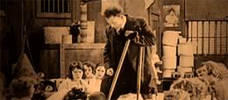Reviews
Scott Witham
30 Reasons to Go Vegetarian, 2005
Credits
Review by David Carter
Posted on 25 October 2007
Source Available direct from PeTA
Related articles
Reviews Cannibal Holocaust
Reviews Cannibal Ferox
Reviews Emanuelle and the Last Cannibals
External links
Video Chew on This
Video Meet Your Meat
Categories 31 Days of Horror
What is food to one, is to others bitter poison.
Roman philosopher Lucretius in De rerum natura
Sometimes I wonder about the karmic implications of my actions.
cannibal Vincent Smith in Motel Hell
Over the past three weeks we’ve taken a look at three classics of the cannibal subgenre of horror cinema. Each film can be seen as a prime example of the wide spectrum of ideas and styles that horror can encompass: Cannibal Holocaust showed us that powerful social criticism is not the exclusive domain of so-called “intelligent” cinema; Cannibal Ferox provides a reminder that blood and gore can become brutal yet beautiful metaphors in the hands of a talented director; and Emanuelle and the Last Cannibals puts us back on even footing, reaffirming our belief that horror is a genre for which entertaining the audience is paramount. We shall conclude with a film that uses social criticism, gore, and entertainment to the same ends, but would likely not be immediately recognized as a horror film.
Animal rights group People for the Ethical Treatment of Animals (PeTA) is the most media savvy of all American non-profit organizations, with a keen grasp on the power of visual media and an often impressive mastery of technical aspects as well. PeTA’s commercials and ads are as memorable as those from the most robustly funded ad agencies, so it should come as no surprise that their freely available DVD PeTA’s Chew On This: 30 Reasons to Go Vegetarian is well-produced and of comparable quality to most studio releases. Chew On This itself is a just over three minute commercial extolling the benefits of abandoning a meat-based diet for a strictly vegetarian one. A multi-ethnic cast of attractive adults and cute kids lists point after point appealing to both logic and emotions.
What does this have to do with horror? Chew On This juxtaposes its points against grotesque footage from animal slaughterhouses. The beautiful presenters are intercut with scenes of chickens, pigs, and cows being killed in graphic detail. The effect is disconcerting, to say the least. The viewer is jarred as the increasingly more brutal and frequent images crescendo towards the commercial’s end, to the point where the actual dialogue is lost against the violent backdrop. It is clear that the visual elements are intended to transgress the aural message, inducing a state of fear or revulsion in the viewer, priming him to submit the message. The use of imagery usually only found in horror films is an odd, yet strangely effective choice. The violent footage in Chew On This is part of another PeTA production called Meet Your Meat, included on the disc as a bonus feature, in which the horror themes are carried to an even greater extreme.
Alec Baldwin narrates Meet Your Meat with a choice of adjectives and adverbs that seem to be cribbed directly from Dr. Francis B. Gross of Faces of Death. Actually, the two films are not dissimilar, with the caveat that Meet Your Meat is all too real. A scene-by-scene recounting would be unpleasant, and frankly pointless; no description could match (or diffuse) the intensity of the disturbing images. Suffice to say that several different types of animals are all shown meeting their demise in unflinching detail, in a manner that easily eclipses similar footage from the aforementioned Faces of Death and its ilk. Again, we find the message overshadowed by the violence. The viewer is not spared any detail of the mayhem as scene after scene of horror passes by the lens in hypnotically rhythmic fashion. The camera finds every drop of blood with a devotion that would only be appealing to the most dedicated gorehound. The film’s message is a simple, provocative one: if you eat meat, you are responsible for the horrific acts you see here.
That debate is not germane to an analysis of Meet Your Meat, nor is this the forum in which to hold it. It is possible to ignore the political aspects and still see the ways in which it conforms to the horror film mold. Baldwin’s narration is somber, staccato, and monotone, his deadpan delivery reminiscent of the opening narration to The Texas Chainsaw Massacre and is even used to precisely the same end: to lend a sense of truth and foreboding to the subsequent images and actions. The footage itself is the most similar to the cinematic trappings of horror and its Mondo/horror brethren, with scenes contextualized by the narration. Removed from any lead-up or resolution, the already disturbing images are given a greater weight because they arrive without warning. The effect is no different from the traditional “jump” scares of horror; no matter how conscious you are of the monster’s presence, the scare chords get you each and every time.
The primary fear generated by horror films is that of loss of control, be it of your control over your ability to stay alive (slashers and the like), your own body (body horror, transformation films, Cronenberg), or even control over your concept of reality (supernatural horror). Meet Your Meat completely strips the viewer of his sense of control from the outset. Faceless workers in unknown locations are shown committing unspeakable acts that the viewers are powerless to stop. PeTA’s moral outrage over the actions can only be transferred to the viewer as fear. Even though you are consciously aware of your own safety, you become afraid. You fear the violence despite the knowledge that you will not suffer the same fate. You become afraid at the implications of the violence because the film places the viewer in a position of responsibility for what’s happening.
Meet Your Meat shares a common subject with Georges Franju’s Blood of the Beasts. But the similarities stop there, particularly with regard to intent and tone. In regard to Franju’s film, Amos Vogel stated, “the killing of animals in Paris slaughterhouses becomes […] a poetic metaphor for the human condition.” Meet Your Meat exists on the opposite end of the spectrum, using gore not as a metaphor but as propaganda. The intent is not to make the viewer question brutality in some greater moral sense but instead to frighten him and to elicit his guilt.
What is horror if not a genre intent to induce fear? PeTA’s choice to use those images of brutality in their promotional materials is not an attempt to convince viewers that vegetarianism is a better way of life; it is an attempt to scare them into being a vegetarian. PeTA have created a graphic and disturbing horror film, intended or not. Ironically, if the film showed human death it would, no doubt, be a hot commodity for so-called gorehounds and other fans of extreme cinema. As it stands, Chew On This/Meet Your Meat is anti-entertainment. The film, perhaps decidedly, is to appeal to no one.
More 31 Days of Horror
-

Alien
1979 -

The Elephant Man
1980 -

My Bloody Valentine
1981 -

Who Can Kill a Child?
1976 -

Cannibal Holocaust
1980 -

Let Sleeping Corpses Lie
1974 -

John Carpenter’s Vampires
1998 -

Jaws 2
1978 -

A Warning to the Curious
1972 -

Wolf
1994 -

The Survivor
1981 -

Cannibal Ferox
1981 -

The Nights of Terror
1981 -

Death Becomes Her
1992 -

Alice, Sweet Alice
1976 -

Body Double
1984 -

Invocation of My Demon Brother
1969 -

Phantasm II
1988 -

Emanuelle and the Last Cannibals
1977 -

The Wicker Man
1973 -

Maniac Cop
1988 -

The Legend of the 7 Golden Vampires
1974 -

The Penalty
1920 -

Boxing Helena
1993 -

Chew on This
2005 -

Night of the Creeps
1986 -

Night of the Lepus
1972 -

Near Dark
1987 -

Army of Darkness
1992 -

The Brood
1979 -

The Lift
1983 -

Amsterdamned
1988 -

Silent Witness
1999 -

The Shaft
2001
We don’t do comments anymore, but you may contact us here or find us on Twitter or Facebook.



